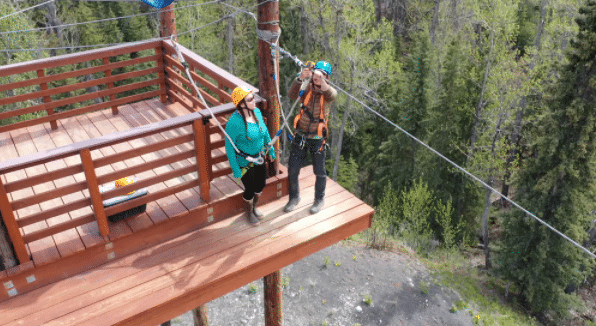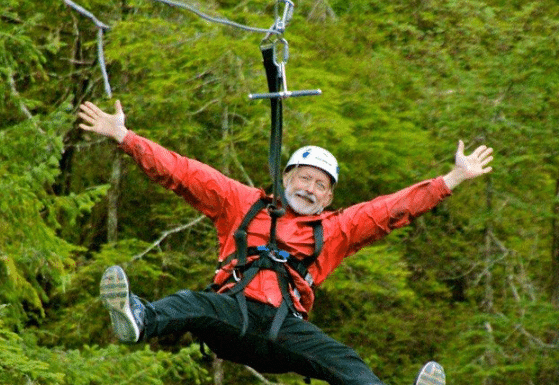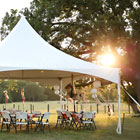A friend asked you to zip line with them this weekend. You don’t see any reason to say no, but you would like to be a little more informed about the process before your trip. How does a zip line work?, When you zip lining, how exactly does everything work?
A zip line works primarily by gravity, starting at a high point on the platform and then mounting a cable system to a lower point. The less friction between the pulley and the cable increases the speed of your terminal so you can ride quickly. The zip line will also include brakes so you can stop safely.
If you want to learn even more about how zip lines work, you’ve come to the right place. In today’s article, we will review the parts of a zip line, the science and physics behind the zip line, and how zip line brakes work. You’ll be ready to go when you finish reading!
The Parts Of A Zip Line
It is difficult to explain how a zip line works without first identifying the various parts of the zip line system. This is what you need to know.
Wheelbarrow
Although you are not in a seat when zip lining, you do so in a seated position. The vehicle you are in, so to speak, is known as the car. Most carts are the size of your body mass, and the size of the cart can influence your zip line speed. How does a zip line work?, You generally don’t have to worry about selecting the correct trolley size as that is the responsibility of the zip line company.
Platforms
As we mentioned in the introduction, the crux of zip lining is that you start at a higher point and then slide down to a lower point. Those two points are platforms. The top deck should be designed at a survey height such that gravity can take hold once you start traveling the line, as this will give you a more satisfying ride. The width of the platform should allow you to stand comfortably without feeling like you are wobbling over the edge.
Brakes
We will have a full section on how zip lines stop, but we want to mention now that yes, brakes are part of the zip line system. How does a zip line work?, In any case, the zip line company should provide a primary set of brakes and then a set of backup brakes that become operational if the first set stops working for any reason.

Cable
The cable is the zip line itself. We just wrote a great introductory post on zip lines that you should check out if you missed it. Most zip lines are made of galvanized steel cable which is stronger than even stainless steel. Every cable in the rope comprises a series of small sized cables for greater durability. Galvanized rope is attached to a pulley, and the pulley is what guides you down when you zip line.
How Does A Zip Line Work?
Okay, now that we’ve got that explanation out of the way, let’s talk about the way a zip line works. First of all, when you arrive at your zip line destination, you will be equipped with a harness and then hooked up to the zip line cable. How does a zip line work?, Remember, the cable itself is connected to a pulley, and the pulley system is what moves it from the first deck to the second.
Well, that and gravity. If we didn’t have gravity, then when you got off the platform, you would just stay there. Fortunately, that is not what happens at all. The sloping design of the zip line from top deck to bottom deck pushes you down.
Here not only gravity is at stake, but also inertia. This physical property determines that matter will continue to move in a straight line until an external force stops it, such as the brakes on a zip line.
You don’t have to worry about going slow when zip lining. The pulley system controls friction as you ride, allowing you to get the kind of speed that adrenaline lovers enjoy. The reason for this is that, compared to slide, rolling down with the zip line will produce less friction. How does a zip line work?, Since friction has a greater force than gravity, you need that lower degree of friction. The steeper the zip line, the faster you’ll normally go, but we’ll talk more about speed a bit later, so be sure to check it out!
How To Stop A Zip Line
You’re whizzing along the zip line at a pretty good speed. You are having a lot of fun, but now you start to wonder when and how you are going to stop. Well, as we mentioned earlier, the zip line system has brakes, as well as a set of backup brakes. Brakes can be active or passive. With the brakes active, you can reduce your speed manually. This is useful when driving down steep slopes or if you have a high top speed.
What you will see much more often when zip lining are passive brakes. Drivers do not control these brakes. Instead, the design of the zip line course is such that the line naturally narrows to stop it.
When stopped like this, several physical properties come into play. One of them is line friction. If you use active brakes as part of the zip line system, then you will be wearing gloves so that you can increase friction and slow down the zip line. How does a zip line work?, Remember, the force of friction is stronger than gravity, so you can slow down with this method.
The second physical force that helps you stop when zip lining is air resistance. What is air resistance, you ask? It is a theory of fluid dynamics that tells us that drag works in the opposite way to relative motion in any moving object and its surrounding fluid. There is a completely complex air resistance formula that implies constant air speed, resistance and density.
The long and the short is this. When a moving object travels quickly, such as your zip line, its air resistance increases. As this happens, your zip line reaches a terminal velocity, which influences the speed of a free-falling object when its resistance prevents the object from increasing faster. How does a zip line work?, In other words, when zip lining, your terminal speed determines what your top speed will be.
With more air resistance applied on the zip line, your speed begins to slow down and eventually stops. Sure you could say that the brakes helped you stop, but there is a lot more science at stake than you ever imagined!

How Fast Do You Go When Zip Line?
As we said we would do, let’s now get into a discussion about zip line speed. Average speed when riding a zip line is 21 to 30 miles per hour at 31 to 40 MPH and sometimes up to 50 MPH. Why the speed discrepancy, you are probably wondering? How fast you can travel on a zip line comes down to a number of factors, so let’s take a look at that now.
How Long Is The Line?
Taking a short zip line trip will not allow you to reach high speeds to the same degree as a longer trip. How does a zip line work?, The longer you have on the zip line, the closer you will be to reaching top speed. This is because gravity and inertia have more time to act.
The Angle Of The Slope
Even on the longest zip line ride, if there is no slope or if the slope is very shallow, then you will not go fast. Remember, gravity is a downward pulling force, which means it must be higher for gravity to do its job. Not only that, but your terminal velocity increases as the slope angle increases, again increasing the speed of your ride.
Your Weight
The last factor that affects zip line speed is your weight. Although you might think that someone who weighs more is destined to travel the line more slowly, the opposite is true. An object that weighs more has a higher terminal velocity compared to a lighter object since its force of gravity is greater. How does a zip line work?, The object will reach terminal velocity more easily and reach its maximum velocity potential in less time.
Final Thoughts
When zip-lining, you stand on a high platform and then go down a line that is attached to a system of pulleys. Physical principles like gravity, inertia, terminal velocity, and air resistance all influence how fast you’ll go, but those aren’t the only factors that have an effect. Your weight, the angle of the incline, and the length of your ride can also influence your speed. Even stopping the zip line is scientific, and requires air resistance and friction.
Please stay connected to our website, ultimatepartyjump for more exciting stuff!
Read More: Inflatable bounce houses safety information












